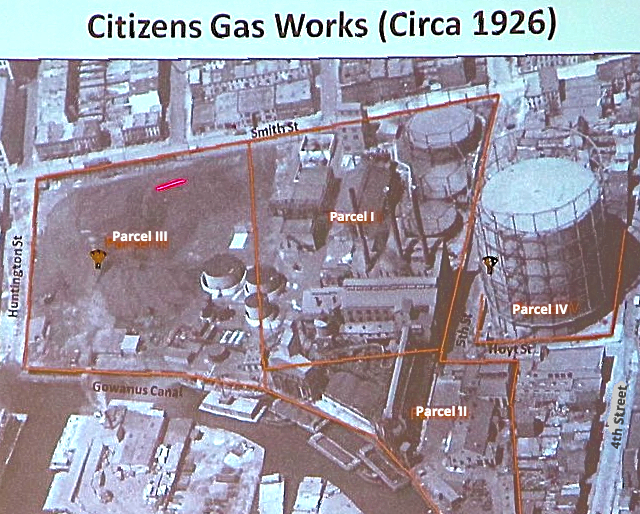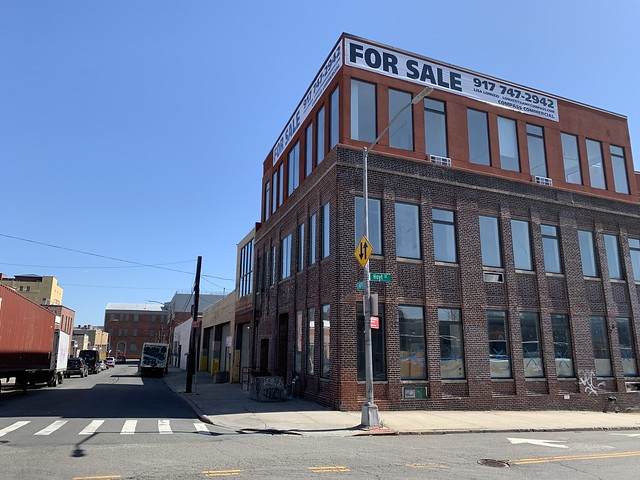
1928 photo of the former Fulton Municipal Works MGP site at Douglass Street,
where Thomas Greene Park is now
Original Sandborne map of the MGP . Green line indicates site of the entire plant
Detail of what is now Thomas Greene Park
Double D pool at Douglas Greene Park
This past Friday,
NYS Department of Environmental Conservation (DEC) released its proposed Environmental Remediation plan for the former Fulton Municipal Works Site near Douglass Street. DEC is asking the public to
submit its comments on the plan by May 3rd, 2015 and will be holding a
public meeting in regards to the clean-up on April 16th at 7 PM.
Why is this important to the Community?
The Fulton Municipal Works Site was one of three Manufacturing Gas Plants (MGP) operated by
Brooklyn Union Gas on the banks of the Gowanus Canal. Coal and petroleum products were turned into flammable gas on these MGP sites. The gas was used for cooking, lighting, heating and commercial purposes in the surrounding neighborhoods.
Unfortunately, one of the by-products of this gasification process is coal tar, a black viscous liquid, which is harmful to the environment
The Fulton Site was in operation from 1879 to 1929. After it was decommissioned by Brooklyn Union Gas, it was never remediated. Eventually,
Douglas Greene Park and the pool at Douglass Street were constructed over the former plant.
Today, the land underneath the park is still heavily contaminated with coal tar. Most of the contamination can be found in the area around and underneath the pool.
The responsibility for the clean-up falls on
National, Grid, which bought Brooklyn Union Gas/Keyspan in 2006, The work will be done under the supervision of
NYS Department of Environmental Conservation.
Since some of the coal tar has been found to ooze from the site into the Gowanus Canal, the
US Environmental Protection Agency, which
declared the canal a Superfund site in 2010, is also involved.
EPA has named National Grid a Potential Responsible Party [PRP], which means that the company has to financially contribute to the Gowanus Canal clean-up.
It is important for National Grid to move forward with the remediation at the Fulton site to make sure that the coal tar present there does not continue to flow towards the Gowanus Canal and re-contaminate it once it has been cleaned.
Why DEC's Proposed Remediation Plan does not seem to go far enough
According to DEC's announcement on the cleanup,
"the primary components of the remedy are the construction of a sealed wall along the western shoreline of the Gowanus Canal and the removal of any coal tar that accumulates behind it.
And further,
Contamination at Thomas Greene Park is well below ground and site structures that prevent public exposure."
Yes, you read that right. After ignoring the contamination for decades, the DEC is proposing to the community to build a wall along Nevins Street that would cut off the coal tar from flowing towards the canal. Any coal tar that accumulates behind that wall will be pumped out.
This basically creates a barrier for the coal tar, but it certainly does not seem to address in any significant way the contamination that will likey remain underneath the pool.
DEC is basically asking the community to continue to live with the pollution, while they are allowing National Grid to kick the problem down the road.
Why would DEC ask the community to settle for less than what it is owed?
One can only guess why DEC would let National Grid get away with doing the least that they can do.
Bear with me.
In September 2013,
the EPA issued its Record of Decision (ROD), which represents the finalized cleanup plan for the Gowanus Canal. In the ROD, EPA included the construction of two retention basins near two of the major outflows to significantly reduce the amount of Combined Sewage material that goes into the canal when it rains.
The City of New York, as a PRP, has to pay for the tanks, a financial responsibility which it has not assumed gladly.
The EPA has suggested constructing the larger 8-million gallon tank underneath the pool at Douglass Green Park. The agency reasoned that the land was already owned by the City. Besides, the largest outflow, which is responsible for much of the raw sewage into the Gowanus, is at the head of the canal at Douglass Street, near the park.
The EPA has told the community that the extend of the work to be done to remove the coal tar from the site may include digging up the pool. This could save the City money since installing the larger retention tank could potentially have been combined with National Grid's work.
Which brings us back to NYS DEC's Proposed Remediation Plan for the Fulton Municipal Works Site. Does DEC truly think that a wall and a couple of collection wells is enough to clean the site of coal tar? Can DEc really think the community is so gullible?
Somehow I can't shake the feeling that DEC is trying to cover for New York City.
Doesn't it seem strange that the DEC seems intent on giving New York City quite a disproportionate amount of space in its Friday statement, which reads in part:
"The NYC Department of Environmental Protection (NYC DEP) recently completed an upgrade to the Gowanus sewage pumping station and is implementing green infrastructure projects that, together, reduce combined sewer overflow (CSO) discharges to the Canal by 44 percent. NYC DEP reconstructed and activated the Gowanus Flushing Tunnel, which now circulates over 250 million gallons of higher quality harbor water through the Canal each day, leading to dramatic improvement in water quality. NYC DEP is also developing a CSO Long Term Control Plan (LTCP) to integrate both Clean Water and Superfund goals for the Canal. The LTCP, which DEP must submit to DEC for review in June, will identify actions to further reduce CSO discharges and improve water quality in the Canal."
I don't l know about you, but DEC seems to be more aligned with the City than with the EPA.
Which is troublesome. Both DEC and DEP have had decades to clean the Gowanus Canal. Neither one of them obviously cared enough about the community or its health to do so.
The EPA seems to be the only agency that consistently advocates for the best, most comprehensive environmental clean-up for the people of Gowanus.
Let us hope that the EPA will continue to show DEC and DEP how its done.
Please join me at the DEC meeting on April 16th to learn more about this.
Below please find DEC's full press release on this action:
NYS Department of Environmental Conservation Seeks Public Comment on Proposed Remediation Plan
for Site Adjacent to Gowanus Canal
Proposed Plan Would Clean Up Contamination at Fulton Municipal Works Site in Brooklyn
Public Meeting Scheduled for April 16; Comments Accepted through May 3
The public is invited to submit comments on a Proposed Remedial Action Plan (PRAP) to clean up contamination at the former Fulton Municipal Works site, adjacent to the Gowanus Canal in Brooklyn, the state Department of Environmental Conservation (DEC) announced today. DEC will also host a public meeting on the proposed cleanup of the former manufactured gas plant (MGP) site on April 16, at 7 p.m. at the Wyckoff Gardens Community Center meeting room, 280 Wyckoff Street, Brooklyn.
The PRAP announced today applies to Operable Unit 1 (OU1) at the site, which includes the property on which the former MGP was located and neighboring properties where contamination is present east of the Gowanus Canal. The site is a principal source of contaminants to sediments in the upper Gowanus Canal. In addition, remedial investigations determined that coal tar from MGP operations at the site has spread in soils below the surface, including under a portion of Thomas Greene Park.
"The cleanup of the Gowanus Canal and adjacent properties is a collaborative effort among state, federal and city government and the private sector, to address sources of the contamination affecting the canal and nearby properties," DEC Commissioner Joe Martens said. "This is another vital step to clean up the site and protect the canal, while minimizing disruptions to current community uses of these areas."
The April 16 public meeting will provide an opportunity for the public to ask questions about the proposed cleanup plan and provide comments. Written comments will also be accepted via mail or email until May 3. Comments may be submitted to:
Henry Willems
NYS Department of Environmental Conservation
Division of Environmental Remediation
625 Broadway
Albany, NY 12233
henry.willems@dec.ny.gov
The proposed cleanup plan would accommodate current site uses and future redevelopment, and also aligns with the U.S. Environmental Protection Agency's (EPA) remediation efforts to prevent recontamination of Gowanus Canal. National Grid, which formerly owned the site, will implement and pay for the cleanup. The primary components of the remedy are the construction of a sealed wall along the western shoreline of the Gowanus Canal and the removal of any coal tar that accumulates behind it. Excavation activities would occur in phases as properties are redeveloped and will not require closures or relocation of occupants or current site uses. Contamination at Thomas Greene Park is well below ground and site structures that prevent public exposure.
The PRAP is part of a multi-tiered approach DEC has taken to help clean up the Gowanus Canal and adjacent parcels. Under a Consent Order with DEC, the NYC Department of Environmental Protection (NYC DEP) recently completed an upgrade to the Gowanus sewage pumping station and is implementing green infrastructure projects that, together, reduce combined sewer overflow (CSO) discharges to the Canal by 44 percent. NYC DEP reconstructed and activated the Gowanus Flushing Tunnel, which now circulates over 250 million gallons of higher quality harbor water through the Canal each day, leading to dramatic improvement in water quality. NYC DEP is also developing a CSO Long Term Control Plan (LTCP) to integrate both Clean Water and Superfund goals for the Canal. The LTCP, which DEP must submit to DEC for review in June, will identify actions to further reduce CSO discharges and improve water quality in the Canal.
Read more


































.JPG)
